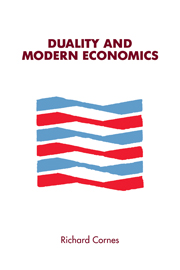Book contents
- Frontmatter
- Contents
- Preface
- PART I SOME BACKGROUND
- PART II MODELING INDIVIDUAL CONSUMER AND PRODUCER BEHAVIOR
- PART III APPLYING THE MODEL OF INDIVIDUAL BEHAVIOR
- Chapter 8 Aggregation analysis
- Chapter 9 Consumer theory and welfare evaluation
- Chapter 10 Externalities and public goods
- Epilogue
- Bibliography
- Author index
- Subject index
Chapter 9 - Consumer theory and welfare evaluation
Published online by Cambridge University Press: 11 September 2009
- Frontmatter
- Contents
- Preface
- PART I SOME BACKGROUND
- PART II MODELING INDIVIDUAL CONSUMER AND PRODUCER BEHAVIOR
- PART III APPLYING THE MODEL OF INDIVIDUAL BEHAVIOR
- Chapter 8 Aggregation analysis
- Chapter 9 Consumer theory and welfare evaluation
- Chapter 10 Externalities and public goods
- Epilogue
- Bibliography
- Author index
- Subject index
Summary
Dual formulations of consumer behavior, in particular the expenditure function, have played a significant role in simplifying welfare evaluation. The source of this simplicity is the fact that elementary revealed preference arguments are naturally built into the dual approach. For this reason, I begin this chapter with a discussion of the revealed preference approach. Although this provides the conceptual core of normative analysis, the exploitation of duality allows us to go further than the simple welfare ranking of alternative allocations. The concepts of equivalent and compensating variations provide unambiguous answers to easily understood questions that one might want to pose concerning the ranking of alternative price-taking situations, and it has been argued that the equivalent variation can provide us with a money metric – that is, a money measure that has all the properties of a utility function and consequently can be thought of as a utility function. Situations involving quantity constraints may be handled by slight modifications of these measures. Furthermore, the use of duality considerably simplifies the definition and analysis of a variety of index numbers. These topics form the subject matter of this chapter.
Revealed preference arguments
Let us begin in simple and familiar territory. A consumer faces a linear budget constraint, P0·q ≤M0. Call this the situation (P0,M0), and denote the chosen bundle by q0 and the attained utility level by u0.
- Type
- Chapter
- Information
- Duality and Modern Economics , pp. 204 - 235Publisher: Cambridge University PressPrint publication year: 1992



